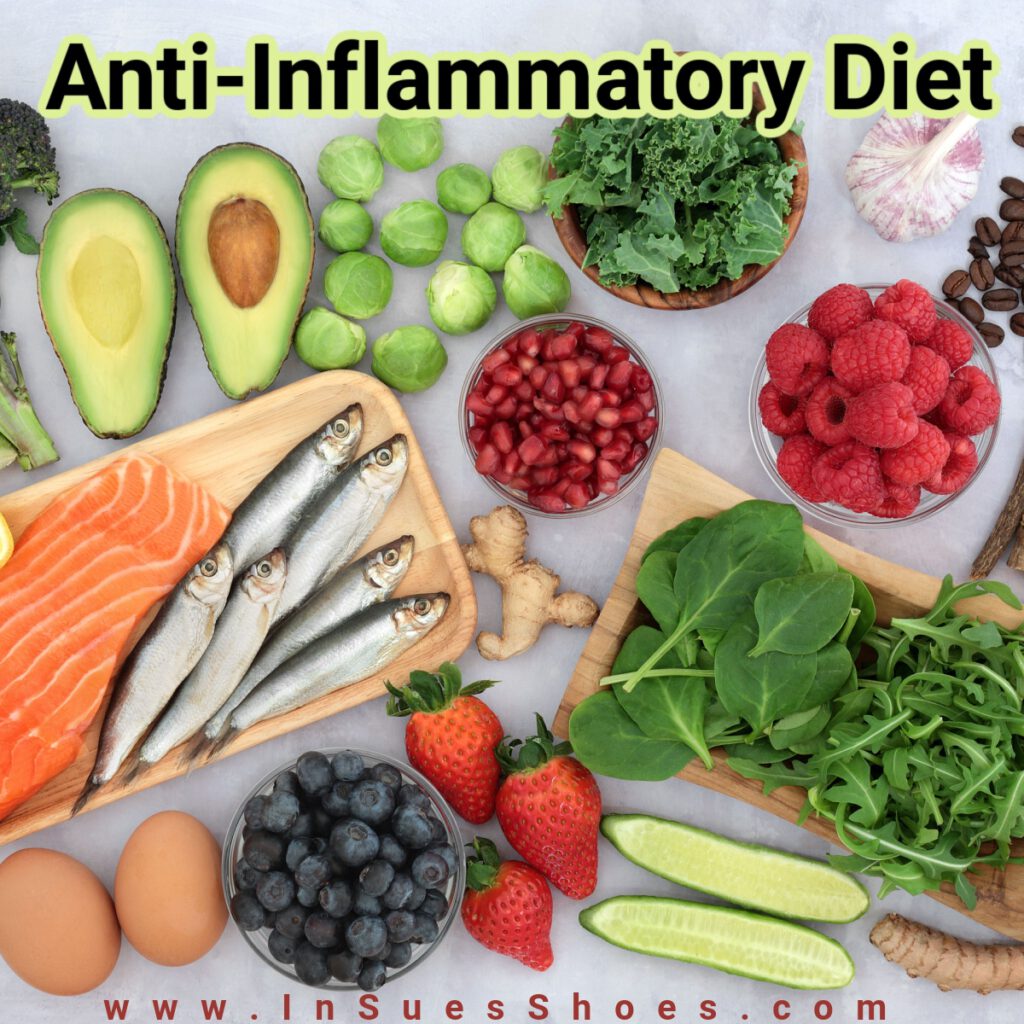Anti-Inflammatory Quick-List

Anti-Inflammatory Diet Guidelines
by Sue, CNC, NASM

We’ve all heard about inflammation. It is, indeed, a natural process, but when inflammation gets out of hand, it creates impairment on our physical and mental well-being. An anti-inflammatory diet can help restore balance. Ready to get started?
But first, rule No. 1: let’s not consider this a DIET. Consider this more of a lifestyle tweak/change. Instead of focusing on what we cannot eat to lower inflammation, let’s focus on what we CAN eat.
Here’s a quick guide for tips we can all absorb into our lifestyles for best outcomes–and lower inflammation.
EAT MORE PLANTS You knew this would be top of the list, right? And for good reason. Fruits and vegetables provide antioxidants, nutrients, and fiber to support optimal health. Eat colorfully – see how many fruits and vegetables you can incorporate into your diet. These low-calorie foods combat cellular damage (hello, antioxidants!), they promote digestion + help maintain a healthy weight–which also keep inflammation in-check.
FATS ARE NOT BAD Eating fat is important for our bodies to work properly. The key? Consuming the right, healthy fats directly reduce inflammation. So what are healthy fats? Sorry–they’re not from bacon (I know… I WISH!). Healthy fats include plant-based options like cooking with olive oil as it contained unsaturated fats the support immunity. Look for omega-3fats, such as fish and walnuts. Avocado, almonds, and pistachios are also excellent options.
SPICE IT UP Add flavor to dishes with herbs + spices that support an anti-inflammatory diet. Consider using turmeric, ginger, cinnamon, and garlic.
FERMENTED ON THE FORK Not spoiled food, but fermented! Consuming certain fermented food helps support a healthy microbiome–the bacteria within your gut. Yogurt, kimchi, and pickles help keep gut bacteria balanced to help your digestive system and to help fight inflammation. High-fiber foods like whole grains and beans also feed beneficial gut bacteria, so as long as you tolerate fiber well, enjoy these and know you’re protecting gut bacteria and keeping the digestive tract ‘moving.’
LIMIT (OR ELIMINATE) PROCESSED FOOD Highly processed foods are everywhere–they’re typically inexpensive to buy, quick to prepare, easy + tasty. They’re also loaded with added sugars, preservatives, they’re chemically altered with foreign ‘stuff’ our bodies just don’t know how to process. When we eat highly processed foods, our cells essentially don’t know how to react–this directly leads to inflammation. Most highly processed foods are also calorie-dense + designed to tell our brains to overeat (it’s science!). Highly processed foods lead to weight gain–and virtually never have nutritional benefit. Recognizing highly processed foods may take some time if this information is new to you. But kudos, because you’re here. So, become a label-reader; you might be surprised at how much within your cupboards is actually unhealthy. One quick very basic rule of thumb: if it won’t spoil in the cabinet or fridge within a week, it’s very likely highly processed + does not belong in our bodies. Want a first step to looking through your pantry? If you have microwave popcorn or boxed cereals, pitch them. We can cover these more in-depth in another article, but these are loaded with sugars + trans-fats that are SO unhealthy. Pitch. Pitch. Pitch. And feel good about it.
CONSUME THE RIGHT MEATS Proteins are imperative, and meats are a key source. But… we need to eat the right meats. You’ll hear cautions of red meats. Red meats are okay, as long as they’re grass-fed, pasture-raised + organic. Should we eat a grass-fed steak every night? Probably not. But red meat from quality, grass-fed organic farms is a-okay for most. (And I bet you’ll notice the flavor is better, too!) Add organic chicken a few days per week, and salmon, tuna, sardines (if you can stomach ’em), or even tilapia or cod a few days per week, and you’ll have a varied, healthy meal plan to satisfy. Protein goals for most are .8 to 1.2 grams of protein per pound of bodyweight.
HYDRATE + SAVOR POWER BEVERAGES We should all be consuming half our body weight in ounces of clean water daily. If you can, avoid water from plastic water bottles and enjoy fresh, filtered, clean water. If plain water gets too boring to consume, make your own ‘spa water’ by adding slices of cucumber, lemon, and some fresh sprigs of mint. Here’s a recipe for a refreshing water that adds extra antioxidants, and is great for gut health.
Enjoy black coffee (organic if you can find it) and unsweetened black or green tea–these offer excellent antioxidant compounds that help fight cell damage. And although no alcohol is good for the body (it really is a poison – unfortunately, I know!), red wine on occasion is fine (daily consumption could be problematic). Again, no alcohol is healthy, but red wine offers resveratrol from the red grape’s skin. Resveratrol is said to assist with mitochondrial health, but if wine affects sleep or gut health, it’s best to avoid.
STRESS Stress affects every part of our lives, right? Inflammation is no exception. When we’re stressed, our cortisol levels increase. When cortisol increases, our inflammation rises. When cortisol (the stress hormone) rises, our immune systems can be weakened, our liver works extra hard–and there is a science-proven correlation between chronic stress, elevated cortisol, inflammation, and fatty liver disease (fatty liver disease can occur in those who do and DO NOT drink alcohol). So, let’s work on lowering stress levels through a healthy diet, regular exercise, and relaxation techniques like meditation + focused breathing exercises. Doing so can help regulate cortisol levels AND reduce inflammation.
